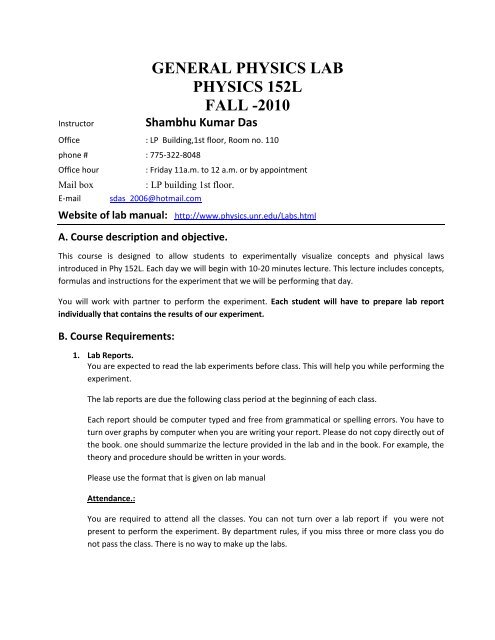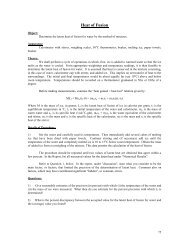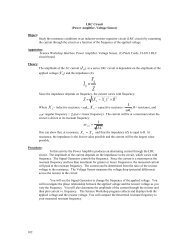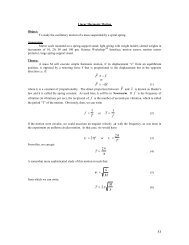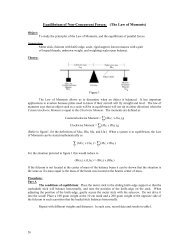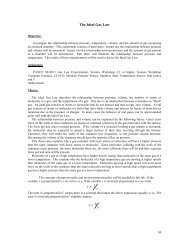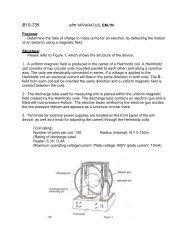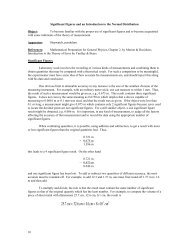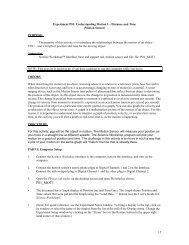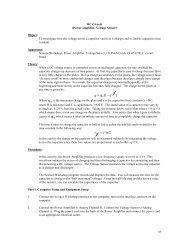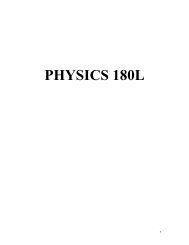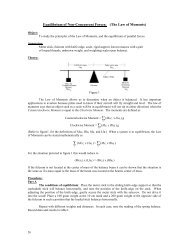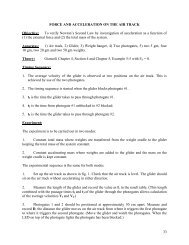GENERAL PHYSICS LAB PHYSICS 152L FALL -2010
GENERAL PHYSICS LAB PHYSICS 152L FALL -2010
GENERAL PHYSICS LAB PHYSICS 152L FALL -2010
You also want an ePaper? Increase the reach of your titles
YUMPU automatically turns print PDFs into web optimized ePapers that Google loves.
Instructor<strong>GENERAL</strong> <strong>PHYSICS</strong> <strong>LAB</strong><strong>PHYSICS</strong> <strong>152L</strong><strong>FALL</strong> -<strong>2010</strong>Shambhu Kumar DasOffice : LP Building,1st floor, Room no. 110phone # : 775-322-8048Office hourMail boxE-mail: Friday 11a.m. to 12 a.m. or by appointment: LP building 1st floor.sdas_2006@hotmail.comWebsite of lab manual: http://www.physics.unr.edu/Labs.htmlA. Course description and objective.This course is designed to allow students to experimentally visualize concepts and physical lawsintroduced in Phy <strong>152L</strong>. Each day we will begin with 10-20 minutes lecture. This lecture includes concepts,formulas and instructions for the experiment that we will be performing that day.You will work with partner to perform the experiment. Each student will have to prepare lab reportindividually that contains the results of our experiment.B. Course Requirements:1. Lab Reports.You are expected to read the lab experiments before class. This will help you while performing theexperiment.The lab reports are due the following class period at the beginning of each class.Each report should be computer typed and free from grammatical or spelling errors. You have toturn over graphs by computer when you are writing your report. Please do not copy directly out ofthe book. one should summarize the lecture provided in the lab and in the book. For example, thetheory and procedure should be written in your words.Please use the format that is given on lab manualAttendance.:You are required to attend all the classes. You can not turn over a lab report if you were notpresent to perform the experiment. By department rules, if you miss three or more class you donot pass the class. There is no way to make up the labs.
If you know ahead of time, you may be able to attend one of the other classes that areoffered. In this situation, let me know and we will contact the TA who is teaching that class.C. Text: Laboratory manual for general physics (available at Physics dept.Office)D. Grading:The lab reports are worth 37 points eachAbstractsTheoryData/calculationsAnalysis5 points10 points8 points14points----------------------TotalLate lab report37points-7 pointsE. Percent of total reports:93-100 (A) 90-less than 93 (A-) 87-less than 90 (B+) 83-less than 87 (B)80-less than 83 (B-) 77-less than 80 (C+) 73-less than 77 (C) 70-less than 73 (C-)67-less than 70 (D+) 63-less than 67 (D) 60-less than 63 (D-) less than 60- FailFINALLY, SINCE EXPERIMENTAL WORK CAN BE SUBJECTED TO HAZARDS OF MANY KINDS. EVERY PERSONWORKING IN THE <strong>LAB</strong>ORATORY SHOULD BE VERY CAREFUL TO AVOID POSSIBLE SAFETY PROBLEMS. BEAWARE TO REDUCE THE RISK OF INJURY AND/OR EQUIPMENT DAMAGE, REPORT ANY ACCIDENT ORBROKEN EQUIPMENT TO ME IMMEDIATELY. NO FOOD, DRINKS OR COSMETICS IN THE <strong>LAB</strong>.
How to Keep a Lab NotebookA lab notebook is the way real scientists keep track of their work. It may seem tedious or evenunnecessary to you, but it is an important part of any lab experience. The notebook should becomplete enough that you could refer back to it in a few years and repeat the experiments.General Guidelines:1. The Notebook must be permanently bound: no loose-leaf or spiral notebooks.2. Handwriting must be legible. Your TA will not grade materials that he or she cannoteasily read. All notes should be taken in pen with the exception of colored drawingsthat may be done with pencils. Errors should be crossed through with a single line, noterased or obliterated.3. All information in the notebook must be handwritten or represent actual results, such asphotographs. Do not place any photocopied material into your notebook unlessspecifically directed to do so.4. Everything you do in the laboratory should be recorded in your lab notebooks,including notes, drawings, data, speculations, etc. Everything from your initial strategythrough planning, execution and interpretation and should be in your notebook.5. Keep all of your lab-related notes, including lab lecture notes, in one notebook. Keep aseparate binder for the lab manual and lab handouts.6. Keep in mind that reports and presentations will be prepared from the notebook. Youshould have much more information recorded in your notebook than you can or shouldput on a poster or into a presentation.The notebook should include:1. The first two pages reserved for a table of contents.2. Notes from lab lectures, discussions and your own research.3. Answers to assigned questions.4. Prelab Section for experiments:
How to Keep a Lab NotebookA lab notebook is the way real scientists keep track of their work. It may seem tedious or evenunnecessary to you, but it is an important part of any lab experience. The notebook should becomplete enough that you could refer back to it in a few years and repeat the experiments.General Guidelines:1.The Notebook must be permanently bound: no loose-leaf or spiral notebooks.2.Handwriting must be legible. Your TA will not grade materials that he or she cannot easilyread. All notes should be taken in pen with the exception of colored drawings that may bedone with pencils. Errors should be crossed through with a single line, not erased orobliterated.3.All information in the notebook must be handwritten or represent actual results, such asphotographs. Do not place any photocopied material into your notebook unless specificallydirected to do so.4.Everything you do in the laboratory should be recorded in your lab notebooks, includingnotes, drawings, data, speculations, etc. Everything from your initial strategy throughplanning, execution and interpretation and should be in your notebook.5.Keep all of your lab-related notes, including lab lecture notes, in one notebook. Keep aseparate binder for the lab manual and lab handouts.6.Keep in mind that reports and presentations will be prepared from the notebook. You shouldhave much more information recorded in your notebook than you can or should put on a posteror into a presentation.
The notebook should include:1.The first two pages reserved for a table of contents.2.Notes from lab lectures, discussions and your own research.3.Answers to assigned questions.4.Prelab Section for experiments:
How to Keep a Lab NotebookA lab notebook is the way real scientists keep track of their work. It may seem tedious or evenunnecessary to you, but it is an important part of any lab experience. The notebook should becomplete enough that you could refer back to it in a few years and repeat the experiments.General Guidelines:1.The Notebook must be permanently bound: no loose-leaf or spiral notebooks.2.Handwriting must be legible. Your TA will not grade materials that he or she cannot easilyread. All notes should be taken in pen with the exception of colored drawings that may bedone with pencils. Errors should be crossed through with a single line, not erased orobliterated.3.All information in the notebook must be handwritten or represent actual results, such asphotographs. Do not place any photocopied material into your notebook unless specificallydirected to do so.
4.Everything you do in the laboratory should be recorded in your lab notebooks, includingnotes, drawings, data, speculations, etc. Everything from your initial strategy throughplanning, execution and interpretation and should be in your notebook.5.Keep all of your lab-related notes, including lab lecture notes, in one notebook. Keep aseparate binder for the lab manual and lab handouts.6.Keep in mind that reports and presentations will be prepared from the notebook. Youshould have much more information recorded in your notebook than you can or should puton a poster or into a presentation.The notebook should include:1.The first two pages reserved for a table of contents.2.Notes from lab lectures, discussions and your own research.3.Answers to assigned questions.4Prelab Section for experiments:Title of experiment and date.The Objective(s) of the lab: what you are trying to do and why you are trying to do it.The Procedure in flow chart or outline form. This should not be an exact copy of the labmanual instructions, but reworked in a manner easy for you to follow.5. Any deviations from your written procedure. This includes changes both intentional andaccidental.6. Observations: everything that happens during your experiment that may have a bearingon the outcome or interpretation of the experiment (this includes color, precipitate, time,temperature, etc).
7. Data: raw and calculated. Use complete sentences, tables and graphs where appropriate.Show sample calculations with steps and units.8. Discussion: Interpret your results. Refer back to your predictions. Draw conclusionsabout experiment. Make suggestions for further experiments or refinements to theprocedure.FORMATE OF <strong>LAB</strong> REPORT AND GRADDING <strong>FALL</strong> <strong>2010</strong>Name:Lab Partners Name:Lab Section:Date of Experiment:Title of the Experiment(1 point for having a title)Abstract (5): A concise statement (a paragraph or two) that summarizes the objectiveand states the numerical results of the experiment, worth a total of 5 points.1 point for having an abstract2 points for summarizing objectives2 points summarizing resultsTheory (10): Summarize in your own words, the theory of the physics involved in theexperiment. Also present the working equations, units and a schematic of the experimentalapparatus. The theory sections should also outline the procedures used in the lab, worth a totalof 10 points.5 points for outlining procedures2 points for having a theory section1 points for stating proper units1 points for expressing relevant equations1 points for defining and explaining relevant termsData (8): An orderly display of the data, preferably in tabular from. You must including theoriginal data sheet signed by the TA. All entries should be clearly identified and include theirproper units, worth a total of 8 points.3 points for a data section2 points for proper/clear labeling of data3 points for proper units of dataAnalysis (14/lab dependent): Must clearly show the computations used to reduce the data. Firstwrite the relevant equations then give a sample calculation. Be sure to includeproper units and use the correct number of significant figures.2 points for having an analysis section2 points for displaying relevant formula2 points for sample computation
2 points for proper units2 points for significant figuresGraphs: 2 points proper units2 points labeling axisResults and conclusion (12):FORMATE OF <strong>LAB</strong> REPORT AND GRADDING <strong>FALL</strong> <strong>2010</strong>A brief Summary of your results, stating the determined value or law,along with its numerical uncertainty. Use proper units and significantfigures. For example, the experimental value for “g” was found to be:Acceleration of gravity g = (9.8 0.2) m/s 2Frequently you will want to compare your result (F) with an accepted value (F o ).A good quantity to compute in this case is the “percent discrepancy” or the“Percent error” which is defined as:PercentDiscrepencyFF0F0100%If you are comparing two values of “F” found in different ways (F 1 and F 2 ) findthe “percent difference” given by:PercentDifferenceFF MF1 2100%Where F M is the mean of F 1 and F 2 . Round off percent errors and differencesto two significant figures. Discuss what you found and compare with whatyou had expected to find. Discuss any discrepancies. One may suggest waysin which to improve the experiment or reduce errors. Some labs may includequestions, worth a total of 12 points.2 points for having a results section2 points stating determined value2 points for stating uncertainty2 points for having a discussion section2 points for summarizing experiment and results2 points for each question answered correctlyGrade = (total points earned / total point available) X 100


